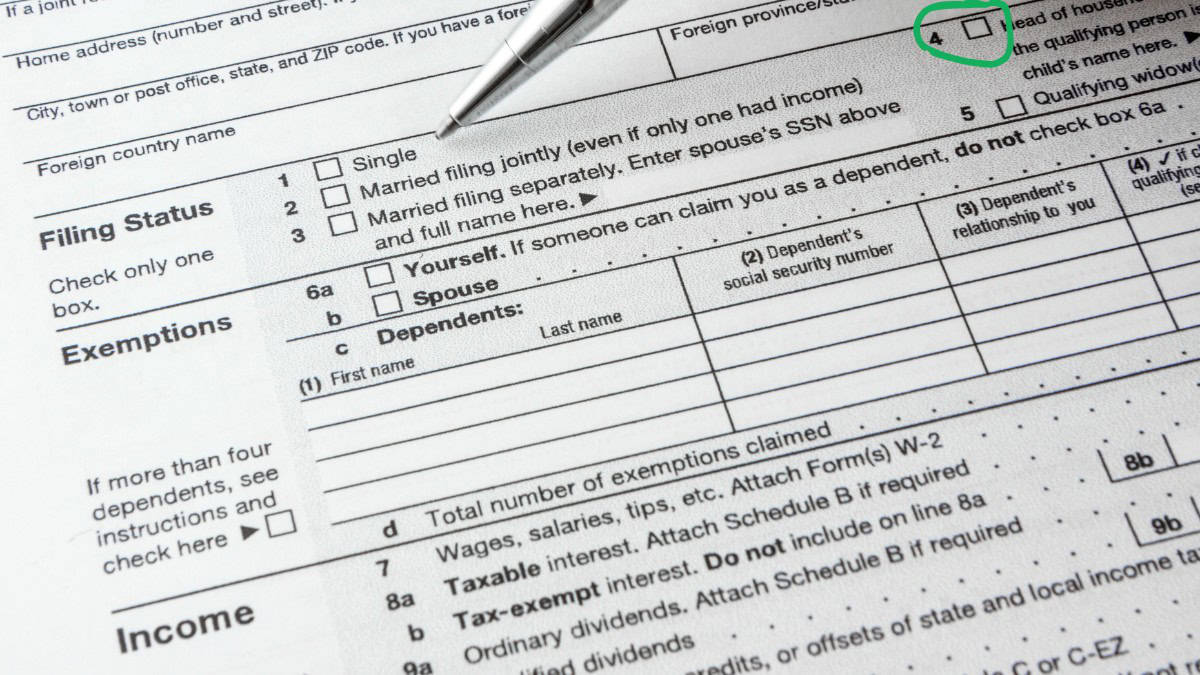Can I File Taxes as Head of Household if I’m Still Married?
A divorcing couple will face more significant financial challenges than a married couple. One of the biggest tax implications that a divorcing couple faces is the change in tax filing status, which will impact their taxable income.
And one or both spouses might wonder, “Can I file head of household if I’m still married?“
When each spouse starts to file separate tax returns, they will end up paying more taxes on their own income than when married. Not paying attention to this could result in paying thousands (or tens of thousands) more in tax dollars than is necessary.
One of the best ways (other than filing a joint return) to lower your tax bill is to file as a head of household on your federal return. However, not everyone can qualify for head of household status.
This article aims to explore a little more about head of household status, so you can determine whether this is an option for you.

Contents
Why Does My Filing Status Matter?
Before we discuss head of household as a tax status, it’s important to look at the different options you might see on your federal income tax return.
These options include:
Married filing jointly
If you’re still married, you’ve probably filed previous income tax returns jointly. This is also known as a joint return. If you’re in the middle of a divorce, then this is probably not a likely option going forward.
However, if you and your ex-spouse are separating under amicable conditions, it might be worthwhile to have your tax preparer run the numbers to see if this is feasible for you. If you can file one last joint tax return, you can take advantage of the lower tax rates.
Of course, this isn’t a permanent solution. And it might not be an option if your divorce becomes final in the early months of the tax year.
Married filing separately
Most married couples who do not file joint returns will file as married filing separately (MFS). In most cases, filing a joint return benefits married taxpayers much more than filing a separate tax return because of the tax breaks.
Married couples filing separately generally:
- Pay a higher tax rate than joint filers at with the same adjusted gross income
- Lose or have limited ability to take many credits or deductions, such as the earned income credit or the child and dependent care tax credit.
- Must include certain types of income that joint filers can exclude (such as interest income for U.S. savings bonds used for higher education expenses)
Single
Most divorcing people will use single filing status unless they qualify as head of household or as a widow.
If your divorce is final before the end of the calendar year, you must file as single unless you qualify for another filing status.
Head of Household
According to the Internal Revenue Service rules, “If you qualify to file as head of household, your tax rate will usually be lower than the rates for single or married filing separately. You will also receive a higher standard deduction than if you file as single or married filing separately.”
In other words, heads of household get better tax treatment than single taxpayers.
Qualifying Widow (or Widower)
You might see this on your federal tax return. Unless either spouse dies before the end of the tax year, this status wouldn’t apply.
The rest of this article will focus on Head of Household status, and how you might qualify.
Head of Household Status
The IRS rules state: “In order to qualify for head of household filing status, you must either be unmarried or ‘considered unmarried’ on the last day of the year.”
If your divorce is not final before the end of the year, then you’re still legally married, right? This begs the question, “What’s the difference?”
Here’s the difference:
Unmarried means that a couple is either not legally married or legally separated from their spouse by divorce or separate maintenance decree.
How to qualify if you’re still married
Even if you’re technically married and not separated, you can still qualify for head of household status.
To do so, you must still be ‘considered unmarried’ on the last day of the taxable year. To do this, you must meet the following requirements:
- Filing a separate return. This includes either married filing separately, single, or head of household status. In other words, not a joint return.
- You paid more than half of the cost of your home’s upkeep for the tax year.
- You and your spouse did not live in the same home for the last 6 months of the year.
- Your home was the main home of your dependent child, stepchild, or foster child for more than half the entire year.
- You are able to claim the child as a dependent.
If you meet these criteria, you could file as either a married spouse filing separately, single (depending on what your marital status was on the last day of the year), or head of household.
Filing Status Comparison
Let’s imagine a divorcing mother who earned $100,000 in 2018. She has one child who has lived with her. Her plan is to take the standard deduction and all applicable tax credits. She meets the head of household criteria, but is trying to determine her options.
She can file as either single or MFS (depending on when her divorce is finalized). It turns out that in her case, both statuses end up with the exact same tax liability: $15,410.
However, if she were to file as head of household, her tax bill would only be $12,588—almost $3,000 less than filing single or MFS.
First, she gets a larger standard deduction ($18,000 versus $12,000). Also, her marginal tax bracket stays at 22%, instead of creeping up to 24% under the other filing statuses.
In this case, our mother would be much better off claiming head of household filing status.
Do I Have To Be Divorced to Claim Head of Household Status?
Here’s where everything gets interesting. Your divorce does not have to be final for you to claim head of household status.
This is where the above criteria come into play. Even if you’re married (and possibly filing as MFS), you could file as head of household if you meet the IRS criteria for being ‘considered unmarried.’
However, you must prove that you meet the criteria. To do this, you would complete Form 886-H-HOH (Supporting Documents to Prove Head of Household Filing Status) when filing your tax return.
How to claim Head of Household Status
According to Form 886-H-HOH, there are three tests that you must pass in order to claim head of household status: Marriage Test, Qualifying Person Test, and Cost of Upkeep Test. Additionally, you must provide supporting documentation. Let’s look at these individually.
Marriage Test
If you’re single, the IRS requires no documentation from you.
If you’re divorced or legally separated, the IRS will require you to provide a copy of one of the following:
- Your divorce decree
- Your separation maintenance decree, or
- Your separation agreement.
And if you’re still married, but did not live together for the last six months of the year, then you need to provide documentation such as:
- Lease agreement
- Utility bills
- Letter from a clergy member
- Letter from Social Services
Qualifying Person Test
Assuming you’ve passed the marriage test, you proceed to the qualifying person test.
A qualifying person has to be someone who has lived with you for over six months of the year. The qualifying person also has to be someone whom you can claim as a dependent.
Finally, the qualifying person has to be an eligible relative. Form 886-H-HOH lists the following as a possible qualifying relative:
- Your child (adopted child, biological child, or child pending adoption)
- Brother or sister, step-brother, step-sister, or any of their descendants
- Eligible foster child
If a possible qualifying person isn’t in this list, the form refers to IRS Publication 501, Dependents, Standard Deduction, and Filing Information.
You will need to provide documentation to verify the person’s relationship to you, such as birth certificates, adoption papers, etc. You will also need to provide documentation that the person lived with you for at least 6 months of the year. This might include school records, medical or daycare records, or a letter on official letterhead.
Cost of Keeping Up a Home Test
If you passed both the marriage test and the qualifying person test, then you must prove that you paid more than 50% of the cost of the home’s upkeep for tax purposes.
To do this, you’ll want to include copies of your receipts and paperwork.

This might include things like:
- Rent receipts
- Utility bills
- Grocery receipts
- Property tax bills
- Mortgage interest statement
- Upkeep and repair bills
- Property insurance statement
- Other household bills
Can both spouses claim head of household status?
There is nothing in IRS Publication 501, Dependents, Standard Deduction, and Filing Information that prohibits both spouses from being able to claim head of household status. However, each spouse must independently meet the criteria on their own.
Specifically, each spouse must have:
- Paid more than half of each home’s upkeep (because they cannot live together for the last six months of the year).
- This presumes there are two separate residences with separate household expenses, and that each spouse has sufficient income to support their own living expenses.
- A qualifying child who is a dependent, who has lived with that spouse for more than half the year.
- Assuming at least 2 dependent children in the relationship, since one child cannot live with both spouses for more than half the year.
Assuming that each spouse independently meets the IRS criteria for filing Head of Household status, there is nothing that prevents both spouses from being heads of household.
Conclusion
By their very nature, divorces force a couple into ‘win-lose’ negotiations. In most cases, one spouse gains at the other spouse’s expense. However, when it comes to taxes, a smart approach could lead to a lower tax bill for both spouses, resulting in more money in both sets of pockets.